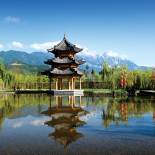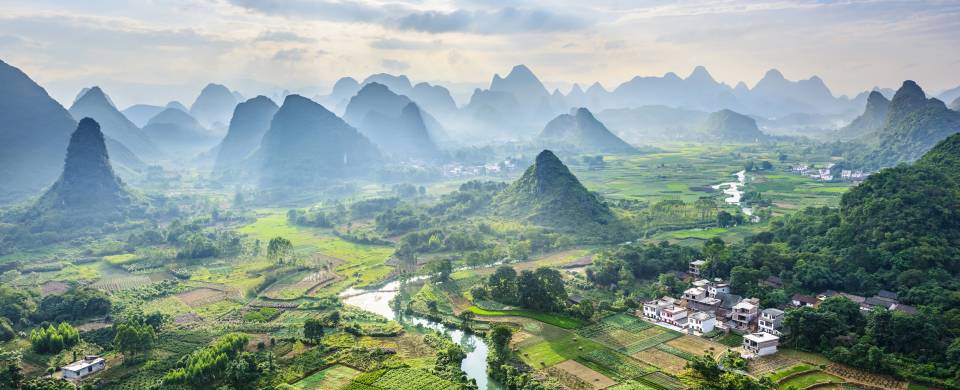
Trips and Tours to Guilin
About Guilin
Considered the pearl in the crown of China's thriving tourism industry, the attractive landscaped city of Guilin is famed for its idyllic scenery of undulating karst hills and verdant vegetation that span out from the Li River flowing through Guilin from north to south. Unsurprisingly, this striking landscape is often the subject of traditional Chinese painting and has long inspired the country's top artists. For many foreign visitors, Guilin and its scenery typifies the exotic Chinese landscape that they have previously only imagined.
Read MoreThe compact city of Guilin makes for a pleasant base from which to explore the natural endowments of the region with plenty of shaded avenues, thoroughfares and rocky parkland to explore within the city limits and great accommodation options. The main points of interest are Elephant Trunk Hill and the Reed Flute Cave. Located on the western bank of the Li River, Elephant Trunk Hill is one of the city's top scenic spots, likened to a large elephant using its trunk to drink water from the river with an almost perfect semi-circular cave between the 'trunk' and 'body' of the elephant. Guilin is also famous for a number of caves including the Reed-Flute Cave, named after the reeds growing around the cave mouth. The gargantuan cave, which eats into the south side of Guangming mountain, represents one of the most extraordinary examples of limestone erosion in China.
A trip to Guilin would not be complete without a leisurely cruise down the Li River to the village of Yangshuo. Taking around 4-5 hours, the Li River boat journey passes wonderful scenes of rice paddies tended by local farmers, water buffalo lazing in yellow fields and fishermen working with their trusty cormorants for the catch of the day. Around each bend you'll be confronted with breathtaking panoramas of towering rocky outcrops punctuated by small hill-top pagodas and sleepy ancient towns.
Guilin Tours
Here are some popular itineraries that include a visit to Guilin. Alternatively, if you would like to include a visit to Guilin on a bespoke touring itinerary to China, take a look at our tailor-made holiday planning section.
Guilin Video
Best sites to visit in Guilin
Li River
View on map
The majority of Guilin's attractions are of the scenic variety located on or around the Li River, the soul of the city and one of China's most iconic and romantic landscapes. From its source in the Mao'er Mountains northeast of Guilin the river flows through striking karst peaks creating twists and turns as it meanders along its route. Little villages hug the banks while fishermen languidly cruise the waters looking for their daily catch. One of the best ways to soak up this poetry in motion is by boat to the village of Yangshuo, a journey of 4-5 hours that passes a number of well-known land formations and sights.
Elephant Trunk Hill
View on map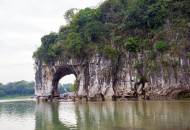
Said to resemble a giant elephant drinking from the waters of the Li River, the Elephant Trunk Hill is one of the area's most recognisable natural attractions and has been a popular tourist destination from as early as the Tang Dynasty. A semicircular cave separates the elephant's "trunk" from its "legs" and is usually reflected in the calm waters in perfect symmetry. The hill forms part of a larger designated scenic park and further up the peak stands the Puxian Pagoda which affords lovely views of the river and surrounding area.
Reed Flute Cave
View on map
The karst peaks of Guilin contain within them incredible limestone cave formations and the most popular and well-known of them is the Reed Flute Cave. Stalagmite towers rise from the ground and chandeliers of stalactites drip from the ceiling to create a natural gallery of shapes and textures further enhanced by the neon light display fitted into the cave. Pools of water beautifully reflect the formations to create a splendid subterranean palace. A visit to the 240 metre-long cave takes around one hour and the collection of Tang Dynasty-era inscriptions inside suggests the cave has been a popular tourist destination for several thousands of years.
South Gate
View on map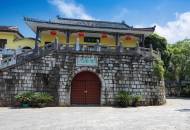
Like many other cities in ancient China, Guilin would have once been enclosed by an imposing defensive city wall though all that remains of this wall today is the beautifully restored South Gate (Gu'nanmen). The wall originated in the Tang Dynasty and was used as an entrance to the city from the north bank of the Banyan Lake and it's still possible to walk through the long tunnel set within the gate that's hidden by a red wooden door. More of Guilin's medieval city layout is visible at the partially restored East Gate (Dongzhen Men) where small sections of the ancient wall still stand though somewhat crumbling.
Sun & Moon Twin Pagodas
View on map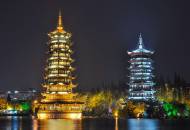
Stood side by side in the water of the Shan Lake, the Buddhist-style Sun and Moon Twin Pagodas are a prominent feature in Guilin's picturesque lake region. The gold-painted Sun Pagoda measures 41 metres tall with nine stories and is one of the few pagodas in the world to feature an elevator. The shorter Moon Pagoda is two stories smaller with aqua-coloured glazed eaves on brown beams and connected to its taller twin by a viewing tunnel beneath the lake's surface. The pair are particularly worth visiting at night when they are illuminated with coloured lights to match their names - yellow for the Sun Pagoda and white for the Moon Pagoda.
Fubo Shan
View on map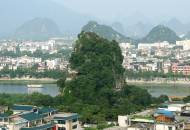
Situated on the west bank of the Li River a few kilometres north of Elephant Trunk Hill, the 213 metre-tall Fubo Shan is another of Guilin's prominent scenic spots affording clear views across the city. Translating as 'wave subduing hill', Fubo Shan stands half on land and half in water and creates a natural hindrance to the ebb and flow of the Li River, calming the movement of the water. This is especially apparent during times of heavy rain. Like many worthy peaks in the area, Fubo Shan has perched on its cliff a pretty pagoda and a cave decorated with statues of Buddha carved from the rock. There's also an unusual stalactite that hangs just 10cm above the ground.
Recommended things to do in and around Guilin
Sail to Yangshuo
View on map
Downriver of Guilin 70km south of the city is the village of Yangshuo, surrounded by some of the region's most incredible karst scenery. A favoured base with travellers wishing to get out and about to explore the surreal landscapes, Yangshuo has become a major attraction drawing visitors in their thousands. Although it's no longer the peaceful haven it once was there's still plenty to entice weary travellers from biking along the river to scaling the cliffs to watching local fishermen catch fish with their trusted cormorants. The preferred way to reach Yangshuo from Guilin is on the Li River by boat.
Hike the Longji Rice Terraces
View on map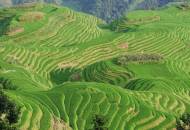
Roughly a two and a half hour drive north of Guilin is one of Guangxi province's most spectacular sights - the cascading rice terraces of Longsheng. Known as the 'Dragon's Backbone' (Longji Titian) for the meandering contours of the terraces that resemble a dragon twisting and turning, the slopes have been cultivated by local farmers for centuries and hiking is pretty much the only way to explore the area. The terraces are particularly stunning after the rains when water collects on the fields and glistens under the sun reflecting the vivid greens of the crops.
Eating out in Guilin
Jinlong Zhai Restaurant
View on mapThis upmarket Guangxi chain has a handful of outlets across Guilin and beyond all offering a tantalising array of authentic local country dishes including roast fowl, Li River shrimps cooked in a clay pot and spareribs accompanying sticky rice. The modern restaurant building on Wenming Road proves particularly popular thanks to its traditional design elements, large dining space and pleasant location surrounded by trees.
Meal prices: $$$
Nengren Shan Su Shi Restaurant
View on mapSituated within the Nengren Buddhist temple in the urban centre of Guilin, the Nengren Shan Su Shi restaurant was the first of its kind to open in the city and has been serving happy diners a mind-boggling array of vegetable dishes for years. There's no English menu or much English spoken but thankfully the menu includes pictures of the dishes or there's always the evening buffet where you can take your pick of delicious and healthy vegetables and dumplings for just $5.
Meal prices: $
Little Italian
View on mapThis small and cozy Western-styled cafe is a great choice for those in search of familiar grub. Located up past the Sheraton Hotel, the Little Italian offers international favourites including traditional thin-based pizza and pasta dishes with a good selection of lighter meals and cakes to complement the very good coffee. Prices are reasonable though the service can be a little slow due to the small kitchen and team of staff.
Meal prices: $$
Chunji Roast Goose Restaurant
View on mapRivalling the capital's delectable namesake dish of Peking duck, the Chunji Roast Goose Restaurant specialises in roast goose with crispy skin and succulent meat across a number of outlets in the city. Goose meat comes in all varieties here from sauteed liver to stir fried intestines. Those less inclined to the bird's innards can stick to the signature dish or the BBQ ribs. The extensive dessert menu is a treat in more ways than one.
Meal prices: $$$
Shopping in Guilin
Guilin Night Market
View on mapThe pedestrian street of Xichenglu comes alive each night with rows of stalls selling all manner of goods that make perfect souvenir gifts from locally-made handicrafts to ethnic textiles, bamboo carvings to paintings. There are also stalls selling modern consumer goods including leather belts and watches, and vendors specialising in local snacks and treats.
Guangxi Normal University Art Shop
View on mapAttached to the university in Guilin, this art shop is heaving with paintings and calligraphy by famed artists throughout the ages. Here you can also pick up tools associated with these arts including writing brushes and beautiful paper as well as quality jade bracelets and other jewellery. Prices reflect the quality of the works with cheaper works by local students also on sale.
Transport links in Guilin
Flying In
View on mapGuilin is served by the Liangjiang International Airport (KWL) located 28km southwest of the city centre which takes around 40 minutes by car. Just under 50 destinations are served from Guilin including non-stop domestic flights to Shanghai, Xi'an , Beijing, and Guangzhou. The five international destinations served are restricted to Asian cities including Bangkok and Seoul. Connections to all major overseas destinations are easily available through Beijing, Shanghai and Hong Kong for those looking to start or end their China tour in Guilin.
Railway Services
View on mapChina's rail network tends to thin out the further west across the country you go though Guilin is well-connected to other major cities with direct services operating to Shanghai, Xi'an, Beijing and Kunming to name but a few. The new Guiyang–Guangzhou high-speed railway connects Guilin with Guangzhou with just a 3 hour journey between the two cities. There are two railway stations in Guilin conveniently called the North and South stations and it's advisable to book tickets in advance as Guilin features on many popular train routes and seats/sleepers book out early.
Best Time to Visit
Guilin's subtropical monsoon climate means the best times to visit are in the autumn months between September and October when the weather is less extreme and temperatures more pleasant with drier conditions and russet hues on the crops and trees. The Li River is at its calmest making it ideal for photography showing the karst landscapes reflected on the water's surface. April is one of the better spring months to visit before the summer rains and accompanying humidity fully kick in. The scenery is also more colourful at this time of year and best if you're after the classic image of lush karst peaks and rice paddies.
